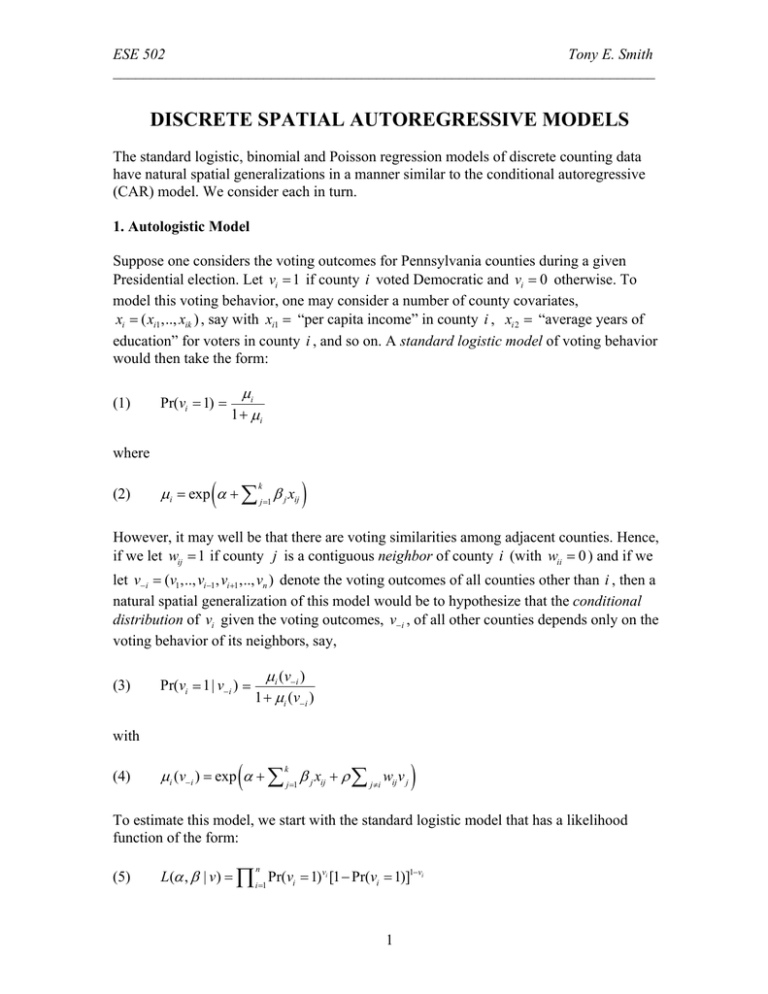Document 10299067
advertisement

ESE 502
Tony E. Smith
________________________________________________________________________
DISCRETE SPATIAL AUTOREGRESSIVE MODELS
The standard logistic, binomial and Poisson regression models of discrete counting data
have natural spatial generalizations in a manner similar to the conditional autoregressive
(CAR) model. We consider each in turn.
1. Autologistic Model
Suppose one considers the voting outcomes for Pennsylvania counties during a given
Presidential election. Let vi = 1 if county i voted Democratic and vi = 0 otherwise. To
model this voting behavior, one may consider a number of county covariates,
xi = ( xi1 ,.., xik ) , say with xi1 = “per capita income” in county i , xi 2 = “average years of
education” for voters in county i , and so on. A standard logistic model of voting behavior
would then take the form:
(1)
Pr(vi = 1) =
µi
1 + µi
where
(2)
(
µi = exp α + ∑ j =1 β j xij
k
)
However, it may well be that there are voting similarities among adjacent counties. Hence,
if we let wij = 1 if county j is a contiguous neighbor of county i (with wii = 0 ) and if we
let v− i = (v1 ,.., vi−1 , vi+1 ,.., vn ) denote the voting outcomes of all counties other than i , then a
natural spatial generalization of this model would be to hypothesize that the conditional
distribution of vi given the voting outcomes, v− i , of all other counties depends only on the
voting behavior of its neighbors, say,
(3)
Pr(vi = 1| v−i ) =
µi (v− i )
1 + µi (v− i )
with
(4)
(
µi (v−i ) = exp α + ∑ j =1 β j xij + ρ ∑ j ≠i wij v j
k
)
To estimate this model, we start with the standard logistic model that has a likelihood
function of the form:
(5)
L(α , β | v) = ∏ i=1 Pr(vi = 1)vi [1 − Pr(vi = 1)]1−vi
n
1
ESE 502
Tony E. Smith
________________________________________________________________________
⇒ log L(α , β | v) = ∑ i=1{vi log Pr(vi = 1) + (1 − vi ) log[1 − Pr(vi = 1)]}
n
where v = (v1 ,.., vn ) and where Pr(vi = 1) is given by (1) and (2). This function is quite easy
to maximize, and yields well behaved maximum-likelihood estimates of α and β .
But for the spatial generalization in (3) and (4) this is not nearly so simple. First, it is not
even clear whether this family of conditional probability distributions is actually consistent
with a common joint probability distribution. Here it turns out that they are indeed
consistent, and that this joint distribution has the form [see for example in Cressie (1993,
section 6.5.1)]:
(6)
Pr(v) =
exp[Q(v)]
∑ s exp[Q(s)]
where:
(7)
(
)
Q(v) = ∑ i=1 vi α + ∑ j =1 β j xij + ρ
n
k
∑
1≤i ≤ j ≤ n
wij vi v j
Hence by definition
(8)
L(α , β , ρ | v) =
exp[Q(v)]
∑ s exp[Q(s)]
with Q(⋅) given by (7). But notice that the denominator is summed over all possible
realizations of v = (v1 ,.., vn ) . So for example if there were only 20 counties, then the
denominator would contain 220 (=1,048,576) terms. Hence even for small numbers of
areal units this function is completely intractable.
Several alternative procedures have been suggested. The simplest is to ignore
interdependencies and consider maximizing the pseudo-likelihood function
(9)
{
L* (α , β , ρ | v) = ∏ i=1 Pr(vi = 1| v− i )vi [1 − Pr(vi = 1| v−i )]1−vi
n
}
in which the marginal probabilities in (5) are simply replaced by the conditional
probabilities in (3). If spatial dependencies are not too great, then it can be shown that this
procedure still yields consistent estimates. However, the procedure turns out to be
extremely inefficient in that the variances of these estimates (especially ρ̂ ) can extremely
large.
2
ESE 502
Tony E. Smith
________________________________________________________________________
An alternative procedure is to simulate values of the joint distribution, as proposed by
Geyer and Thompson (1992). The idea is very simple. If we let θ = (α , β , ρ ) and write (6)
as
(10)
Prθ (v) = Pr(v) =
exp[Q(v)]
exp[Q(v)]
=
c(θ )
∑ s exp[Q(s)]
then for any given set of parameter values, say θ 0 = (α 0 , β 0 , ρ0 ) , it follows that
(11)
1 = ∑ v Prθ (v) =∑ v
c(θ ) = ∑ v
exp[Q(v)]
⇒ c(θ ) = ∑ v exp[Q(v)]
c(θ )
exp[Qθ (v)] exp[Qθ0 (v)]
exp[Qθ (v)]
exp[Qθ0 (v)] = c(θ 0 )∑ v
exp[Qθ0 (v)]
exp[Qθ0 (v)] c(θ 0 )
exp[Qθ (v)]
= c(θ 0 ) ⋅ Eθ0
exp[Qθ0 (v)]
But since θ 0 is known, it follows that if we can simulate this distribution, and obtain
sample values, v( s ) , s = 1,.., N , then we can obtain corresponding sample estimates,
(12)
N exp[Qθ (v( s ) )]
1
Eˆθ0 (θ ) = ∑ s =1
N
exp[Qθ0 (v( s ) )]
of the mean value in (11). This in turn implies that
(13)
cˆ(θ ) = c(θ 0 ) ⋅ Eˆθ0 (θ )
and thus that we can approximate the function c(θ ) up to an unknown constant of
proportionality, c(θ 0 ) . Hence this approximation can be used to obtain approximations the
likelihood function in (10). Notice that while this simulation procedure is time consuming,
it only need be done once, since the same samples v( s ) , s = 1,.., N can be used in every
round of the iterative maximization procedure to obtain estimates θˆ = (αˆ , βˆ , ρˆ ) .
2. Auto Binomial Model
Next suppose that one is looking at housing abandonments in Philadelphia, and has data
h = (hi : i = 1,.., n) on the number of abandoned houses in each block group i = 1,.., n . If the
abandonment probabilities depend on a number of housing attributes xi = ( xi1 ,.., xik ) as well
3
ESE 502
Tony E. Smith
________________________________________________________________________
as the frequency of abandonments in neighboring block groups, and if the total number of
housing units in i is denoted by N i , then one might consider conditional binomial
probabilities of the form:
(14)
N
Pr(hi | h− i ) = i pi (h− i ) hi [1 − pi (h−i )]Ni −hi
hi
where
(15)
pi (h− i ) =
µi (h− i )
1 + µi (h−i )
with
(16)
(
µi (h− i ) = exp α + ∑ j =1 β j xij + ρ ∑ j ≠i wij h j
k
)
Here these conditional binomials can again be shown to be consistent with a joint
distribution of the form
(17)
Pr(h) =
exp[Q(h)]
∑ s exp[Q(s)]
where:
(18)
(
)
Q(h) = ∑ i=1 hi α + ∑ j =1 β j xij + ρ
n
k
N
n
wij hi h j + ∑ i=1 log i
1≤i ≤ j ≤ n
hi
∑
Hence the Geyer-Thompson procedure can again be used for estimation.
3. Auto Poisson Model
Finally, if the N i ’s are quite large, then it is reasonable to approximate the auto binomial
model by an auto Poisson model of the form:
(19)
[λi (h− i )]hi
Pr(hi | h− i ) =
exp[−λi (h− i )]
hi !
with
(20)
(
λi (h− i ) = exp α + ∑ j =1 β j xij + ρ ∑ j ≠i wij h j
k
4
)
ESE 502
Tony E. Smith
________________________________________________________________________
For the Poisson approximation to the auto binomial, λi (h− i ) replaces the binomial mean
values, N i pi (h− i ) . In all cases, the appropriate joint distribution takes the form (17) with
(21)
(
)
Q(h) = ∑ i=1 hi α + ∑ j =1 β j xij + ρ
n
k
∑
1≤i ≤ j ≤ n
wij hi h j − ∑ i=1 log(hi !)
n
However, it turns out that this model is only well defined if ρ < 0 ! The problem can be
seen from (20) where the influence of neighboring counts always increases the expected
number of counts at i when ρ > 0 . This mutual inflation procedure can easily be shown to
drive counts to infinity (since there is no upper bound on counts in the auto Poisson model).
Some efforts have been made to rectify this [see Augustin, N.H., et al. (2004) ] by
considering truncated auto Poissons of the form,
(22)
Pr(hi | h− i
{[λ (h )]
)=
∑ {[λ (h
i
−i
hi
N
k =0
−i
i
}
/ hi ! exp[−λi (h− i )]
)] / k !} exp[−λi (h− i )]
k
; hi = 0,1,.., N
Notices that if N is replaced by N i for each i then this starts to look very much like the
auto binomial model above. Hence this truncated model is most useful in cases where there
are no reference populations (as for example when looking at the number of traffic
accidents in each areal unit).
Finally, if we let
(23)
(
)
Q(h) = ∑ i=1 hi α + ∑ j =1 β j xij + ρ
n
k
∑
1≤i ≤ j ≤ n
wij hi h j + ∑ i=1 Di (h−i )
n
with
(24)
Di (h−i ) =
∑
Ni
N
k
log
− ∑ k =0 {[λi (h− i )] / k !} exp[−λi (h− i )]
i =1
hi
n
then the joint distribution consistent with these truncated conditional Poissons is again
given by (6). So Geyer and Thompson (1992) can again be used for maximum likelihood
estimation of the parameters.
References:
Cressie, N. (1993) Statistics for Spatial Data, New York: Wiley.
Geyer, C.J. and E.A. Thompson (1992) “Constrained Monte Carlo Maximum Likelihood
for Dependent Data”, Journal of the Royal Statistical Society B, 54: 657-699.
5
ESE 502
Tony E. Smith
________________________________________________________________________
Augustin, N.H., et al. (2004) “Using the truncated auto-Poisson model for spatially correlated counts”, http://www.stats.gla.ac.uk/Research/TechRep2004/04-14.pdf
6







